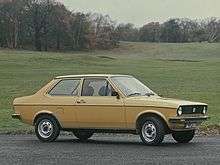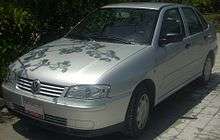Volkswagen Derby
| Volkswagen Derby | |
|---|---|
 | |
| Overview | |
| Manufacturer | Volkswagen |
| Production | 1977–1981 |
| Assembly | Wolfsburg, Germany |
| Body and chassis | |
| Class | Supermini (B) |
| Body style | 2-door saloon |
| Layout | Front-engine, front-wheel-drive |
| Platform | Volkswagen A01 platform |
| Related | Volkswagen Polo |
| Powertrain | |
| Engine |
0.9 L I4 (petrol) 1.1 L I4 (petrol) 1.3 L I4 (petrol) |
| Transmission | 4-speed manual |
| Dimensions | |
| Wheelbase | 2,330 mm (91.7 in)[1] |
| Length | 3,866 mm (152.2 in)[1] |
| Width | 1,559 mm (61.4 in)[1] |
| Height | 1,352 mm (53.2 in)[1] |
| Curb weight | 745 kg (1,642 lb)[1] |


Volkswagen Derby was the name originally given by German automaker Volkswagen to its booted saloon (three-box) version of the first-generation Volkswagen Polo, between 1977 and 1981. Later in the mid-90's, the Derby name was used outside Europe by Mexico's Volkswagen subsidiary, in order to introduce a new saloon car to its domestic market, also a saloon version of the European Polo.
Overview
With 72,412 sold in 1977 alone the car was initially popular, outselling the Polo sister model in that year, but sales quickly tailed off in subsequent years.[2]
During 1981, Volkswagen introduced the second generation Polo and the second generation Derby; in 1984 the Derby name was dropped and the saloon version of the Polo became the Volkswagen Polo Classic.
Most parts of the Derby are interchangeable with the Mk1 Polo, and many drivetrain components are compatible with the Mk2 models. Body parts at the rear and also the rear window are different and are directly attributable to the original design version of this vehicle, which was intended to be marketed as the Audi 60. Lights of the early version are the same as the Mk1 Polo and the car which began this design: the Audi 50, which dates to just before the full merger of Audi and Volkswagen.
This was 1979 Semperit Irish Car of the Year in Ireland.
Versions available
In Europe, the Derby was available with 0.9-litre (895 cc), 1.1-litre (1,093 cc) and 1.3-litre (1,272 cc) four-cylinder engines, with 40, 50 and 60 bhp respectively. The Derby Formel E ("Formula E"), offered in 1981 only, was an economy-optimised Derby featuring, among other things, a longer ratio gearbox, automatic engine turn-off when idling and a high compression version on the 1.1 L engine that demanded super instead of regular petrol. The Formel E concept was also available on other contemporary VW and Audi models.
The following versions were available:
- 900 L
- 1100 LS
- 1100 LX
- 1100 CLS
- 1300 LS
- 1300 GL
- 1300 GLS
- 1100 Formel E
In 1979, the Derby underwent a face lift together with the Polo. The restyle attempted to separate the styling of the Polo and the Derby more significantly, which also brought the styling of the Derby into line with its bigger counterpart the Volkswagen Jetta. These revisions included rectangular headlamps, a restyled grille and plastic bumpers, together with some interior changes including a new dashboard and instrumentation taken from the Mk1 Golf.
In 1984, the Derby was re-badged as the Polo Classic in Europe, and the Derby's unique squared headlamp front end, which had been carried over from the Mk1, was replaced with standard Polo equipment.
In the UK, the Derby name was dropped with the Mk1, and the Polo Classic name was used from the Mk2's inception. However, early Polo Classics still retained the Derby styling. In turn, the "Classic" branding for the saloon was dropped in 1987 which meant that the Polo and Derby integration was complete.
In 1991, the Polo saloon version was withdrawn and would not return until 1996, when a version based on a badge-engineered Seat Córdoba platform was launched.
Marketing
This saloon version of the first generation Volkswagen Polo was not sold outside Europe, although some parts of Eurasia did get it (Turkey, Cyprus and Malta were the main export markets within Eurasia) and also some parts of Eastern Europe bordering on Asia.
The Derby name was later used outside Europe by Volkswagen of Mexico between the 1995-2008 period, in order to domestically commercialize the third generation Volkswagen Polo Classic saloon.
Mexican Volkswagen Derby (1995-2008)

Mexico's Volkswagen subsidiary started using the Derby name in order to launch an all-new compact saloon car to its domestic market in the middle of the 90's decade.
Introduced by November 1994, the Mexican-market first Derbys actually were rebadged units of the SEAT Córdoba first generation model, produced by Spain's Volkswagen partner SEAT. These were imported from Spain until late 1995, just featuring Volkswagen badges instead of the SEAT original badges (since Volkswagen Group didn't launch the Spanish brand in Mexico until year 2001). By 1996, domestic units were assembled at Mexico's Volkswagen manufacture with Spain-imported parts.
Production in Mexico of these units (as first Derbys) was interrupted at some point in 1997, in order to re-launch the car as an all-new
mid-1998 model. By the time, the Mexican Volkswagen "new Derby" would actually be the European-market third-generation Volkswagen Polo Classic. It came with 1.8 L engine with 90 hp and five-speed manual gearbox.
In 2002, production of the third-gen Polo Classic stopped in Europe, but continued in South America, specifically in Argentina where it was already being manufactured (and offered to its domestic market as Polo Classic, such as in Europe). Thus, Volkswagen of México continued offering this model in its lineup as Derby, importing the Argentinian-produced units. A comfort version was offered as Derby "Wolfsburg Edition". A bit later, Trendline and Sportline editions were introduced (featuring a 2.0 L engine for the second one).

Circa 2006, the Argentinian-produced third-gen Polo Classic got a slight "makeover", mainly spotted on the headlights, front grille, taillights and bumpers. These elements design was inspired on those from the previously applied facelift to the first-gen SEAT Córdoba, back in 1999 (Ultimately, both the Córdoba and the third-gen Polo Classic shared the same platform). Mexican VW's subsidiary remained to offer this renewed model as Derby until late 2008, when it was finally discontinued due to its dropping sales while another models grew in the market share. Sales for year 2008 were around 2,987 sold units. Argentinian VW's subsidiary continued offering the model in its lineup until late 2010 (as Polo Classic, all the time).
A lightweight cargo vehicle was designed around the third-gen Polo Classic and launched to Mexican and South American markets as the Volkswagen Caddy first, while in Mexico it is known as the Volkswagen Van.
References
External links
| Wikimedia Commons has media related to Volkswagen Derby. |
| Volkswagen Passenger Cars, a marque of the Volkswagen Group, car timeline, European market, 1950–1979 — next » | ||||||||||||||||||||||||||||||||||
|---|---|---|---|---|---|---|---|---|---|---|---|---|---|---|---|---|---|---|---|---|---|---|---|---|---|---|---|---|---|---|---|---|---|---|
| Type | 1950s | 1960s | 1970s | |||||||||||||||||||||||||||||||
| 0 | 1 | 2 | 3 | 4 | 5 | 6 | 7 | 8 | 9 | 0 | 1 | 2 | 3 | 4 | 5 | 6 | 7 | 8 | 9 | 0 | 1 | 2 | 3 | 4 | 5 | 6 | 7 | 8 | 9 | |||||
| Economy car | Beetle (Type 1) | |||||||||||||||||||||||||||||||||
| Supermini | Polo I | |||||||||||||||||||||||||||||||||
| Derby I | ||||||||||||||||||||||||||||||||||
| Small family car | Type 3 | Golf I | ||||||||||||||||||||||||||||||||
| Large family car | Type 4 | |||||||||||||||||||||||||||||||||
| K70 (NSU) | Passat I | |||||||||||||||||||||||||||||||||
| Coupé | Karmann Ghia | Scirocco I | ||||||||||||||||||||||||||||||||
| Type 34 Karmann Ghia | VW-Porsche 914 | |||||||||||||||||||||||||||||||||
| Utility vehicle | Type 181 Kurierwagen/Trekker | |||||||||||||||||||||||||||||||||
| ||||||||||||||||||||||||||||||||||
